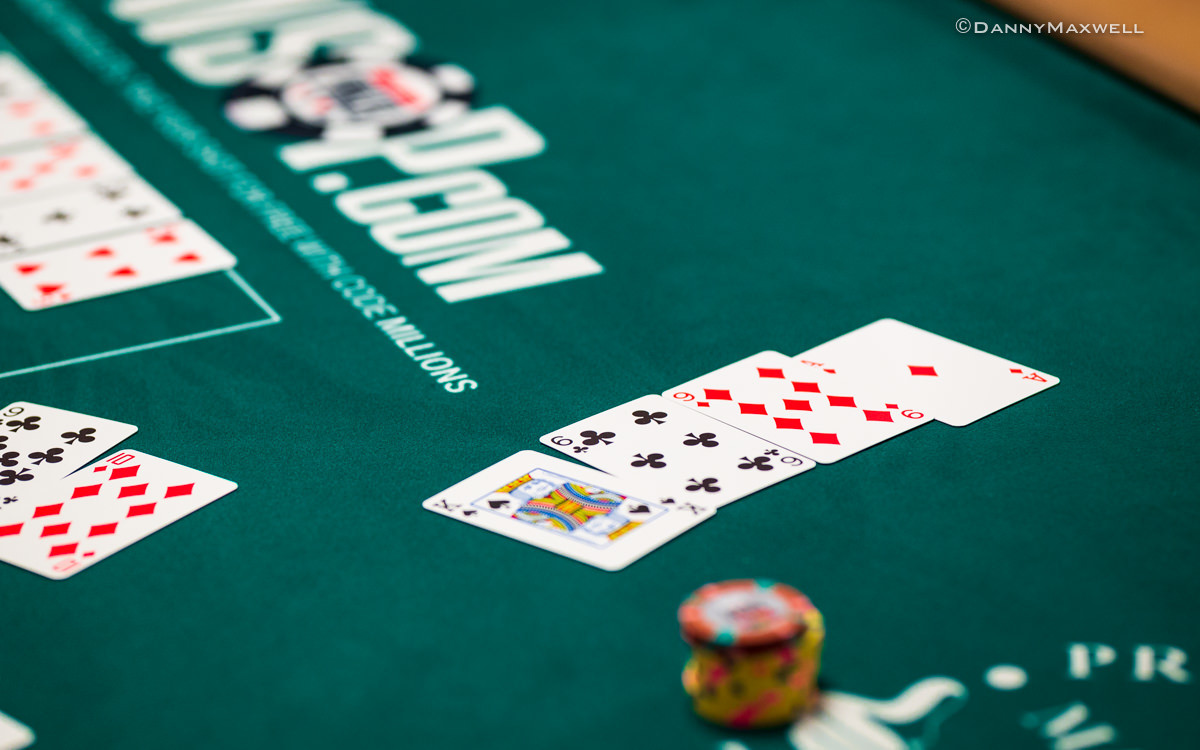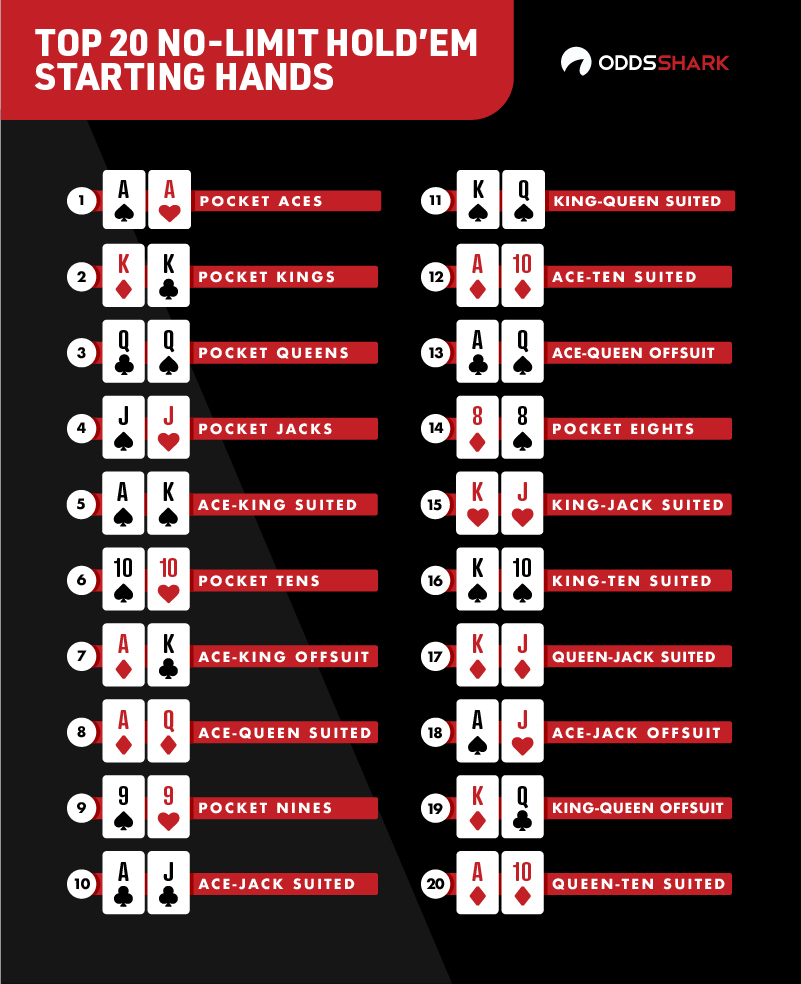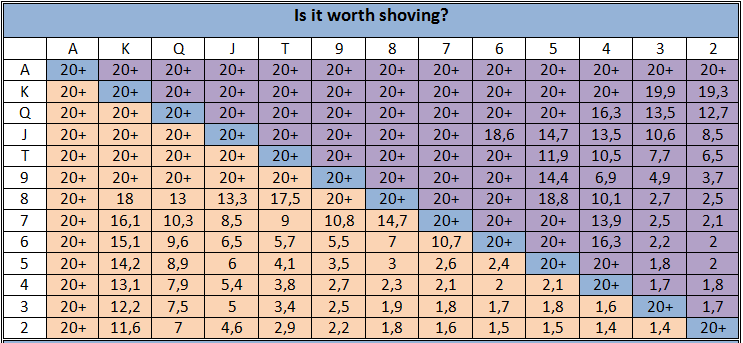If I were teaching a new player to play no-limit hold’em, and my goal were to get this player up to a professional level of play, how would I do it? What would my lessons look like?
- Top 10 Starting Hands In No Limit Poker Rules
- Top 10 Starting Hands In No Limit Poker Tournaments
- Top 10 Starting Hands In No Limit Poker Bonus
- Top 10 Starting Hands In No Limit Poker Table
Let’s say I had only three months to do it. With most people, I will admit, it would be a tall order. The learning curve is steep these days, and I don’t think everyone could make it from zero to pro in that short a time.
When Hellmuth refers to his Top 10, he is talking about pocket card, starting hand requirements. One should note that this isn't a list of the only hands Hellmuth plays, but he does suggest that the poker player can make lots of money in low limit poker, by waiting on these cards and playing them aggressively. Without further ado, Hellmuth's. The Rest of the Top 20 Hold'em Hands. The top 10 best starting hands in Hold’em are a good starting point for poker players but every potential starting hand can be ranked all the way down to the lowly 7-2 off suit, which only has a 4% chance of winning versus random cards. The list of 10 Common No Limit Hold’ Em mistakes below is not strictly geared towards the beginning poker player. If you find yourself in a downswing, it may not be just variance. Take a look at the list below to be sure you plug up any leaks. Playing marginal hands out of position.
I’d have to make compromises. I couldn’t try to cover every possible situation. I’d have to find the important bits and skip the rest.
I’d also have to tailor the lessons a bit to a specific type of game. The most important skills in some game types are not as important in others. With this in mind, here are what I think my top five lessons would be for a new player trying to beat the $2-$5 no-limit hold’em games in Las Vegas.
Now, let's talk about starting hands in Texas Hold'em. Ranking The Top 20 No Limit Texas Hold’em Starting Hands. I wanted to include something a bit more exciting in this article, so here's the top 20 No Limit Hold'em starting hands in terms of raw all-in equity (or percentages). TOP 10 MOST AMAZING POKER HANDS EVER!Help us to 200K Subscribers - you are reading this, comment what poker video you want to see next.
Lesson No. 1. Don’t limp into pots ever. And don’t call preflop three-bets unless you are trapping with an ultra-premium hand.
Limping into pots, calling the preflop raise, and then check/folding the flop when you miss is an enormous leak. It’s also one that nearly every player who hasn’t been specifically coached out of it exhibits.
In my opinion, most players would see an immediate improvement in their winrates if they simply refused to limp in with any hand, especially if they chose to instead fold most of these hands.
For most players, refusing ever to limp means playing much tighter, particularly from out of position. Until you’re already an established pro player, tighter is better.
Lesson No. 2. Don’t pay off big turn and river bets.
This lesson might be different in some types of games, but in the Las Vegas $2-$5 games, it’s easily a candidate for the single most important piece of advice. Do not pay anyone off. When someone makes a big turn or river bet or raise, your one pair hand (or whatever other hand you’re thinking about calling with) is a bluff-catcher. That means, in the great majority of cases, your opponent won’t be trying to make a value bet with a worse hand. Either you’re beat or your opponent is bluffing. And players in these $2-$5 games do not bluff often enough to make calling worthwhile.
So you don’t pay off. I know it can be frustrating to feel like you’re getting muscled out of a huge pot, but the fact is, most players in these games do very little muscling. They try to make hands, and then they bet the hands they make. A big bet usually means a big hand. You don’t need to call to find out for certain.
Lesson No. 3. Your opponents will limp into pots, call raises, and check/fold flops. Take advantage of this weakness by raising lots of hands with position, betting the flop, and often also betting the turn.
It’s a simple play, but it’s one that generates a very consistent profit in these games. Players play too loosely preflop, are too willing to call preflop raises after limping in, and are too willing to check/fold the flop or turn if they miss. With many players, you can ignore your cards and raise the limps, bet nearly all flops, and bet most turn cards as well.
Say two typical players limp in a $2-$5 game. You raise to $25 on the button. Both limpers call.
The flop comes 10 8 2. They check, and you bet $50. One player calls.

The turn is the 5. Your opponent checks, you bet $120, and he folds.
In this scenario, and in many like it, it doesn’t matter what you have. Your opponents are beating themselves by playing call/call/fold so often. All you have to do is put the bets out there and let your opponents run repeatedly into the brick wall.
Yes, there is some nuance to this, and some boards are better bets than others. But against many opponents at the $2-$5 level, most flops, turns, and even rivers are good bets. Keep betting until your opponents prove to you that they won’t beat themselves by folding too much.
Lesson No. 4. With value hands, don’t try to blow opponents out of pots. Instead, play most value hands with the goal of keeping a player in through the river.
Value hands — hands like top pair, two pair, or any other hand you think is a favorite to be best — lose their value when all your opponents fold. If you win without a showdown, you might as well have been holding 7-2. (See Lesson No. 3.) With your value hands, you generally want opponents to get to the river.
Most players like to see showdowns if they feel like they can see them without losing too much money. No one likes to fold and think, “What if I was good?” If your opponents get to the river, often it’s an easy sell to get them to call a final value bet (as long as you don’t make it too big).
Calling these value bets is one of the biggest mistakes that $2-$5 players make. (See Lesson No. 2.) Allow your opponents to make this mistake.
Most players try to end hands early when they feel like they have the best hand. “Don’t want to get drawn out on,” they think. But this is backward thinking. End hands early with strong bets when you have nothing but a weak draw. Allow hands to reach showdown when you actually have something to show down! (Makes sense when I put it that way, doesn’t it?)
If I have top pair, I’d much rather get called for $30, $50, and $80 on flop, turn, and river than get called for $30 and then blow my opponent out of the hand with a $100 bet on the turn. The chance to win $160 with the hand instead of $30 outweighs the risk that I’ll get outdrawn.
Lesson No. 5. Think every hand about what strategies your opponents are using and how they’re thinking, and (almost) ignore the two cards in your hand.
I’ll put it bluntly. Most $2-$5 players beat themselves. They tend to play strategies that are extremely transparent, overly simplistic, and inflexible. You can beat some of these players simply by betting every time it’s your action (See Lesson No. 3.) You can beat other of these players simply by waiting for hands that beat top pair/no kicker and then making value bets. (See Lesson No. 4.)
Your job as a poker player is to identify the strategy each opponent is using and deploy a counter strategy. In many cases, the two cards in your hand become irrelevant. My experience is that the players that are always thinking about their hands never figure it out. It’s the players who are thinking on the next level that do. ♠
Ed’s newest book, Playing The Player: Moving Beyond ABC Poker To Dominate Your Opponents, is on sale at notedpokerauthority.com. Find Ed on Facebook at facebook.com/edmillerauthor and on Twitter @EdMillerPoker.
When you first start playing poker it’s important that you are quickly able to recall hand rankings and the strength of the hand you’ve been dealt. Fortunately, it’s pretty easy to do so, as highlighted in this complete guide to the 10 strongest poker hands, with their rankings listed in order from highest to lowest. Furthermore, the rankings are standard for all the most popular types of poker games including No-Limit Hold’em, Pot-Limit Omaha and Seven-Card Stud.
In addition to a poker hand rankings chart, also provided are answers to some of the most frequently asked questions regarding poker hand rankings, as well as the game of poker in general.
1. Royal Flush
A ‘Royal Flush’, otherwise known as a ‘Royal Straight Flush’ or ‘A Royal’, is the best possible hand in poker. It consists of ace, king, queen, jack and ten, with all five cards of the same suit, such as As-Ks-Qs-Js-10s.
This unbeatable hand is rare, though, with the odds of making a royal flush just 1 in 30,939 or 0.0032 percent using 7 cards. These odds apply to the game of Texas Hold’em where you build your hand using 5 cards, but still have 7 cards to choose from, namely 2 pocket cards and 5 on the board.
2. Straight Flush
A ‘Straight Flush’ consists of five cards in a row that are all in the same suit. It essentially combines a straight with a flush, with an example being Jc-10c-9c-8c-7c. This powerful hand rarely gets beaten, but in the eventuality of a showdown between straight flushes the player with the highest top card wins. Bear in mind that suits are irrelevant in poker and that only kickers are used to separate same ranked hands.
The odds of making a straight flush is 1 in 3,589, or 0.0279 percent.
3. Four of a Kind
A Four of a Kind, otherwise known as ‘Quads’, consists of any four of the same value cards in each of the four suits. For example Ks-Kh-Kc-Kd-2s is a four of a kind hand. In Texas Hold’em, if the community cards dealt complete four of a kind on the board, such as 10c-10s-10h-10d-7c, the player with the highest hole card wins. In the example provided, however, if none of the players have a card higher than a 7 the hand is drawn.
Four of a kind hands are strong and rarely beaten, with the odds of making such a hand 1 in 594, or 0.168 percent.
4. Full House
A ‘Full House’ is any three of a kind hand combined with a pair. An example of such a hand would be Ah-Ac-Ad-Kc-Kd, or “aces full of kings,” which is the best possible full house hand and would in turn beat a lesser-ranked full house, as well as a flush, a straight, or any other hand ranked lower on this list.
Also referred to as a ‘Full Boat’, the odds of making a full house is 1 in 37.5 or 2.60 percent.
5. Flush
A ‘Flush’ is fifth highest on the poker hand rankings list, and consists of five cards of the same suit, but not in consecutive order. An example would be Ac-Jc-9c-7c-5c or Qd-10d-7d-5d-2d. Between two flushes, the one with the highest-ranked card wins the hand, with an ace-high flush the best possible flush. Therefore, an ace-high flush beats a king-high flush, a king-high flush beats a queen-high flush, and so on. This is a hand that even a super tight poker player would play.
The odds of making a flush is 1 in 32.1, or 3.03 percent.
6. Straight
A ‘Straight’ consists of five consecutive cards in numerical order, but not of the same suit. In this hand, aces can count both as a high or low card. For example, the lowest possible straight, also known as the ‘Wheel’ or ‘Bicycle’, is five-high as in 5h-4d-3s-2c-Ad, while the highest referred to as ‘Broadway’ is ace-high as in Ad-Ks-Qh-Jc-10s.
The odds of making a straight is 1 in 20.6 or 4.62 percent.

Top 10 Starting Hands In No Limit Poker Rules
7. Three of a Kind
A ‘Three of a Kind’ hand consists of any three cards of the same face value, and two non-paired cards. An example would be Ah-As-Ad, with a King and a Queen as side cards, which is also the best possible three of a kind hand. The term ‘Set’ and ‘Trips’ both refer to types of three-of-a-kind hands, but in a set you must hold a pair in your hand. By contrast, trips are when there is a pair on the board and you hold a third matching card in your starting hand, such as a 6c-6s-Kh-10h-5d board and you hold a 6d in your hand.
The chances of making a three-of-a-kind hand is 1 in 19.7, or 4.83 percent.
8. Two Pair
Any ‘Two Pair’ hand consists of two cards of the same face value together with another two cards of the same value. For example Jc-Jd-6c-6h-Kc. If two players both hold two pair then the player with the biggest pair wins. At the top of the two pair ranking order is aces and kings with a queen kicker.
The odds of making two pair or ‘Top Two’ as it is also known is 1 in 3.26, or 23.5 percent.
9. One Pair
A ‘One Pair’ hand means you have two cards of the same face value and three other non-matching cards. For example Ac-Ad-Qc-9d-3h or 10d-10h-7c-5d-2h. In a pair versus pair situation, like the previous example, the higher pair always wins, with two aces the best possible one-pair hand. Where two players have the same pair the player with the next highest card wins.
Also known as a ‘Pocket Pair’, the odds of making such a hand is 1 in 1.28, or 43.8 percent.
10. High Card
When a player has five unpaired cards the highest-ranked card plays. The highest possible high card in poker is an ace, which would beat a king high hand, and so on. For example, an Ac-Qh-10d-7s-3h hand would beat a Kd-Jc-9h-7c-5s hand.
The odds of not making a pair is 1 in 4.74, or 117.4 percent.
Poker Hand Rankings FAQs
Do hand rankings vary between different poker games?
All the most popular “high-card” poker games use the standard poker hand rankings based on five cards only and listed in order from highest to lowest. These include Hold’em, Omaha, Seven-Card Stud, and Five Card Draw. On the other hand, “low-card” games, known as Lowball, use an alternate low hand ranking in which the lowest possible hand wins. Badugi, 2-7 Triple Draw, and Razz are examples of such Lowball games.
Do my extra cards matter in poker?
When playing Texas Hold’em, it’s important to remember that the best five card hand takes the pot. If you and your opponent have the same hand, however, then the highest kicker comes into play. For instance, if your holding is A-9 versus K-10 for your opponent and the board comes Q-Q-Q-Q-8, then your quads and ace high hand would beat your opponent’s quads and king high hand. If, however, the highest kicker is a community card then its a split pot. An example of this would be if you had 10-9 versus your opponent’s 10-7 on a 10-K-K-A-Q board, as you both have two pair each, tens and kings, with a communal ace high card.

Which suit is ranked the highest in poker?
Most poker games do not rank one suit more valuable than another, with all suits considered of equal value. A spade Royal Flush, for instance, is considered of equal value as one comprised of either diamonds, hearts or clubs.
What is a ‘draw’ in poker?
Top 10 Starting Hands In No Limit Poker Tournaments
A ‘draw’ or ‘drawing hand’ in poker is when a player’s hand is incomplete and needs an additional card or cards in order to become valuable. There are many types of draws associated with the game of poker, such as flush draws, straight draws, open-ended straight draws, and inside straight draw, to name but a few. A flush draw, for example, is a hand with four matching suited cards that needs another card of the same suit to improve to a flush. Similarly, a straight draw is where a player needs to hit one card of a certain rank in order to complete a straight.
What are the 10 best starting hands in Hold’em?
Top 10 Starting Hands In No Limit Poker Bonus
It can be difficult to rank the best starting hands in Hold’em because you’re always going to have hands where pocket aces get cracked. In general, however, the following 10 hands are considered the best versus any two random cards:
Top 10 Starting Hands In No Limit Poker Table
- 1. Pocket Aces
- 2. Pocket Kings
- 3. Pocket Queens
- 4. Ace-King Suited
- 5. Pocket Jacks
- 6. Pocket Tens
- 7. Ace-Queen Suited
- 8. Ace-King Offsuit
- 9. Ace-Jack Suited
- 10. King-Queen Suited